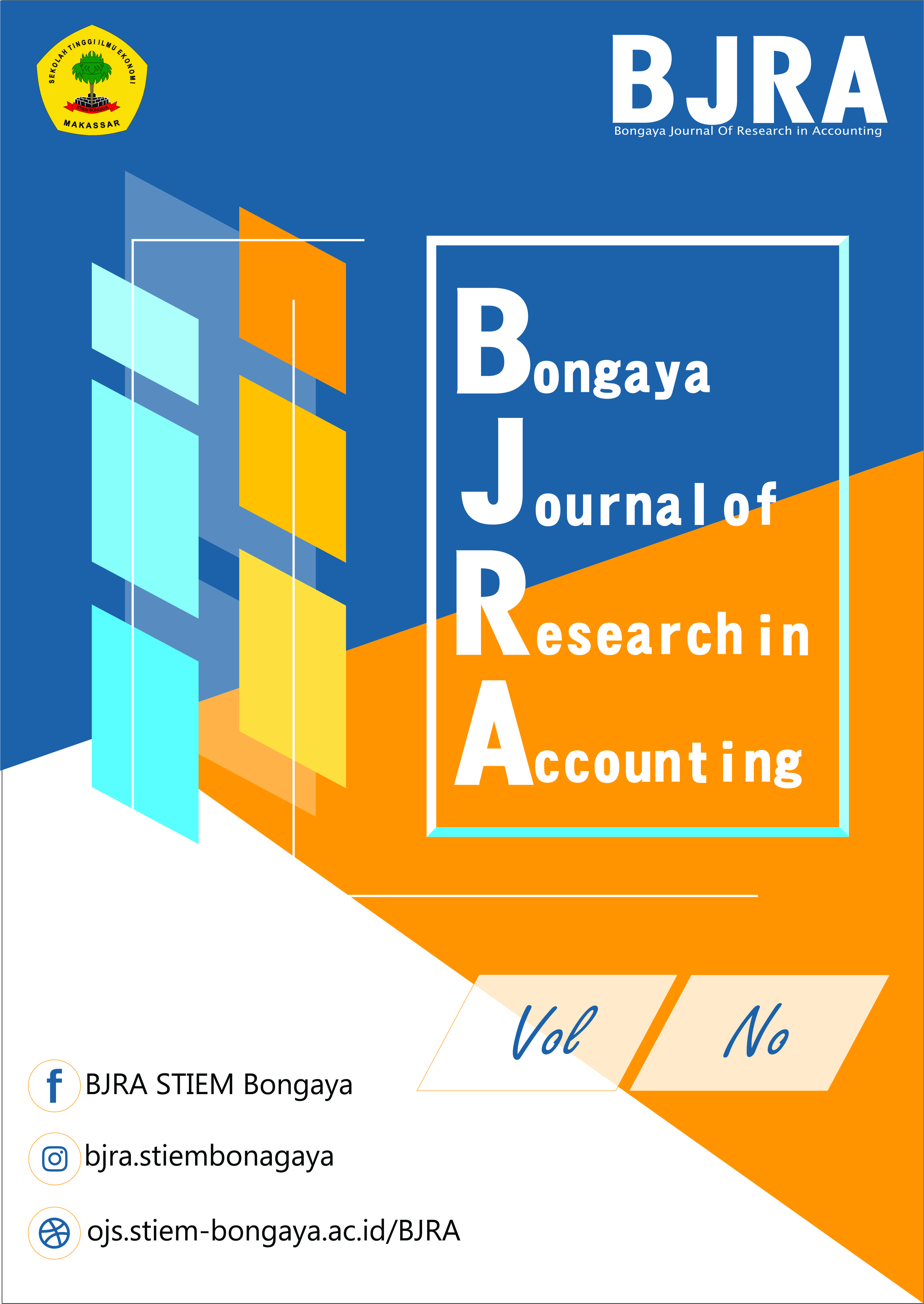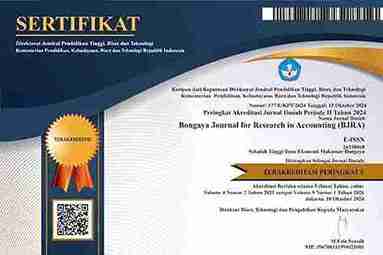Analisis Pengaruh Fraud Pentagon Terhadap Fraudulent Financial Reporting Menggunakan Beneish Model
DOI:
https://doi.org/10.37888/bjra.v5i2.367Keywords:
: Beneish Model, Fraudulent Financial Reporting, Fraud Pentagon, Financial Stability, Purposive Sampling.Abstract
This study discusses the analysis of the influence of Pentagon Fraud on Fraudulent Financial Reporting using the Beneish Model. Pentagon fraud is an independent variable in this study. Proxies that can be used for this research include pressure which is proxied by financial targets and financial stability. Opportunity (opportunity) which is proxied by ineffective monitoring and quality of external auditors. Rationalization (Rationalization) which is proxied by change in auditor and auditor's opinion. Capability which is proxied by the change of the company's directors. Arrogance is proxied by the frequent number of CEO's picture and CEO politician. The dependent variable uses Fraudulent Financial Reporting which is measured using the Beneish Model. This model uses 8 (eight) calculation ratios, namely, Days Sales in Receivable Index (DSRI), Gross Margin Index (GMI), Asset Quality Index (AQI), Sales Growth Index (SGI), Depreciation Index (DEPI), Sales and General Administration Expenses Index (SGAI), Leverage Index (LVGI), and Total Accrual (TATA). The object of research is a company that is included in the LQ-45 index for the 2019-2020 period listed on the Indonesia Stock Exchange (IDX), the sample taken for the study is 33 companies based on the Purposive Sampling method. The results of this study are (1) Financial stability (ACHANGE) has a significant effect on Fraudulent Financial Reporting. (2) Financial target (ROA), Ineffective Monitoring (BDOUT), Quality of external auditor (KAE), Change in auditor (AUDCHANGE), Opinion auditor (AO), Change in Board of Director (DCHANGE), Frequent number of CEO's picture (CEOPIC) and Politicians (OSHIP) have no significant effect on Fraudulent Financial Reporting.
References
Agus Pramuka, Bambang dan Ujiyanto. 2007. Mekanisme Corporate Governance, Manajemen Laba dan Kinerja Perusahaan. Simposium Nasional Akuntansi.
Agustina, Ratna Dewi dan Dudi Pratomo. 2019. Pengaruh Fraud Pentagon Dalam Mendeteksi Kecurangan Pelaporan Keuangan. Jurnal Ilmiah MEA (JIMEA), 3(1)
Al Badrus, Ahmad. 2017. Model pendeteksian fraudulent financial statement menggunakan analisis fraud pentagon. Skripsi Program S1. Fakultas Ekonomi Dan Bisnis. Universitas Islam Negeri Syarif Hidayatullah. Jakarta.
American Institute Of Certified Public Accountant (AICPA). Statement of Auditing Standard. 99
American Institute of Certified Public Accountants ( AICPA). 1989. Codification of Statement on Auditing Standars. New York : American of Public Accountants.
Annisya, M., Lindrianasari, L., & Asmaranti, Y. 2016. Pendeteksian Kecurang Laporan Keuangan Menggunakan Fraud Diamond. Jurnal Bisnis dan Ekonomi, 23(1).
Association of Certified Fraud Examiners Indonesia Chapter. 2014. Survai Fraud Indonesia 2012. Jakarta: ACFE Indonesia Chapter.
Beneish, Messod D. 1999. The Detection of Earnings Manipulation. Financial Analysts Journal, 55(5): 24-36.
Gugus Irianto, Nurlita Novianti. 2018. Dealing With Fraud. Malang: UB Press.
Nguyen, Khanh. 2008. Financial Statement Fraud: Motives, Methodes, Cases, and Detection. Florida
Priantara Diaz. 2013. Fraud Auditing & Investigation. Jakarta: Mitra Wacana Media
Rezaee, Zabihollah. 2005. Causes, Consequences, and Deterence of Financial Statement Fraud. Critical Perspectives on Accounting 16 (2005) 277–298.
Septriani Yossi, dan Desi Handayani. 2018. Mendeteksi Kecurangan Laporan Keuangan dengan Analisis Fraud Pentagon. Jurnal Politeknik Caltex Riau, 11(1): 11-23
Siddiq, F.R., dan Agus Endrianto. 2019. Fraud Pentagon Theory Dalam Financial Statement Fraud Pada Perusahaan Terdaftar Di Jakarta Islamic Index (Jii) Periode 2014-2017 (Perspektif F-Score Model). Jurnal Nusamba, 4(2)
Siddiq, Faiz Rahman, Fatchan dan Zulfikar. 2017. Fraud Pentagon Dalam Mendeteksi Financial Statement Fraud. Seminar Nasional dan The 4th Call for Syariah Paper, ISSN 2460-0784
Sihombing, Kennedy Samuel. 2014. Analisis Fraud Diamond Dalam Mendeteksi Financial Statement Fraud :Study Empiris Pada Peusahaan Manufaktur yang Terdaftar di BEI. Fakultas Ekonomi dan Bisnis, Universitas Diponegoro.
Skousen, C. J., Smith, K. R., & Wright, C. J. 2009. Detecting and Predicting Financial Statement Fraud: the Effectiveness of the Fraud Triangle and SAS No. 99. Corporate Governance and Firm Performance Journal, 13(1): 53-81.
Soselisa, Rangga dan Mukhlasin. 2008. Pengaruh Faktor Kultur Organisasi, Manajemen, Strategik, Keuangan, dan Auditor Terhadap Kecenderungan Kecurangan Akuntansi: Studi pada Perusahaan Publik di Indonesia. Simposium Nasional Akuntansi XI, Pontianak, Indonesia, 23- 24
Sugiyono. 2014. Metode Penelitian Pendidikan Pendekatan Kuantitatif, Kualitatif, dan R&D. Bandung: Alfabeta.
Suheni, Venny dan Muhammad Faisal. 2020. Mendeteksi financial statement fraud dengan menggunakan model Beneish M-score. Jurnal Akuntansi dan Ekonomi, 5(2)
Tessa, Chyntia G.,Puji Harto. 2016. Fraudulent Financial Reporting: Pengujian Teori Fraud Pentagon Pada Sektor Keuangan Dan Perbankan Di Indonesia. Simposium Nasional Akuntansi XIX, Lampung.
Vona Leonard W. 2008. Fraud Risk Assessment: Building A Fraud Audit Program. New Jersey: John Wiley and Sons, Inc'
Wells, J. 2011. Corporate Fraud Handbook: Prevention and Detection. Hoboken, New Jersey: Wiley.
Wolfe, David T. Dana R. Hermanson. 2004. The Fraud Diamond: Considering The Four Element of Fraud. CPA Journal. 74.12: 38-42. The Fraud Diamond: Considering The Four Elements of Fraud. The New York State Society of CPA










